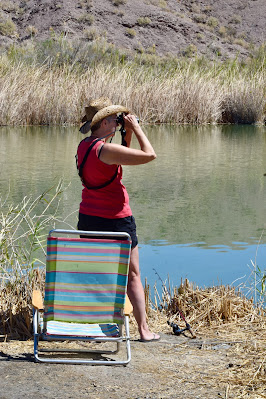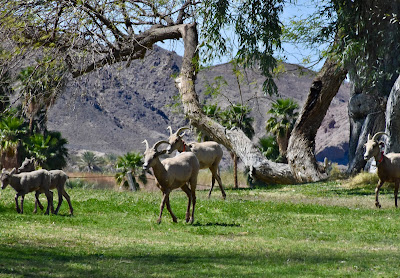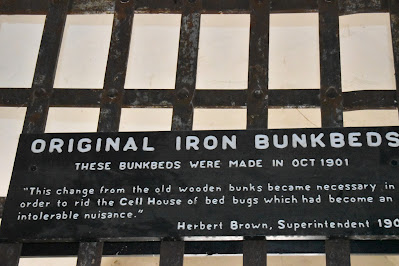Broccoli, birds, bighorns, behind bars
Agriculture is king in these parts. Water from the Colorado, which is sadly diminished by the time it flows through here, is the lifeblood of crop cultivation, although it appears that some is irrigated with well water. I've seen both sprinkler irrigation and ditch/furrow watering; thus I'm now an expert on all things agricultural here . . . well, maybe not all things.
I'm always interested in how various crops are harvested, so it was timely that we got to watch broccoli being taken directly from the field and tucked safely into boxes ready for the supermarket. We watched the process shown in the photos below. It works like this: a horizontal line of pickers is mostly under a shade roof cutting heads and passing them up to others on a platform in front of them. There, the broccoli is trimmed and packed into boxes, which are placed on a conveyor belt that takes them to an attached truck where they are stacked for transport. The picking/packing station is transported slowly forward by a tractor. I expect the mechanism can clear a field very efficiently.
The cauliflower, though, is another matter. We saw several fields that looked similar to what's pictured below: sections looked as if the leaves were wilted down and/or tractors had been through with the heads exposed, while other parts were mostly upright leaves. In all cases, the cauliflower was unblanched and unharvested. I hope to discover the answer to this mystery.
Wetlands . . .
All that water flowing through the river and its many channels and oxbows, not to mention manmade ditches and canals, provides magical riparian oases in the otherwise dry dusty flatlands. We quite enjoyed wandering along with binoculars in hand, sighting waterfowl and dryland species at every juncture. It's amazing how they find their niche in the grand scheme of things.
The bird list for the trip expanded quickly as we drove and walked different environments, and some of course right in the RV park, such as Gila woodpecker along with the ubiquitous house finch, mourning dove, Eurasian collared dove, great-tailed grackle, northern mockingbird, raven and house sparrow.
On and around the water, we saw red-winged blackbird, American coot, double-crested cormorant, neotropic cormorant, ring-necked duck, ruddy duck, great egret, snowy egret, Clark's grebe, pied-billed grebe, western grebe, Cooper's hawk, red-tailed hawk, belted kingfisher, common merganser, northern harrier, northern shoveler, white pelican, black Phoebe, Gambel's quail, lesser scaup, cliff swallow, violet-green swallow, cinnamon teal, Wilson's warbler and yellow-rumped warbler.
Curiously, when we stopped to identify distant pelicans, we saw two people on a tiny island about six feet across with absolutely no sign of how they came to be there. They were wearing street clothes and had no boat or other conveyance. They were too far away to hail, so we left them to their fate and me with my curiosity piqued.
At the trailer, we put up a hummingbird feeder and saw both Costa's and black-chinned. One amusing avian interaction occurred after a house finch repeatedly visited the feeder but was stymied because it contained no seeds. On one still-hopeful visit, he was joined by a hummer that was feeding. Aha - the light bulb went on when he saw how it was done! Alas, although he imitated the hummingbird's feeding method, still no seeds were present and he flew away. I'm fairly certain I saw a quizzical look on his countenance.
A venerable headgate structure still stands, although unused, over a vegetation-choked canal. I'm guessing the U.S.R.S. initials inscribed into the cement way back in 1907 stand for the United States Reclamation Service.
The many man-made waterways transporting valuable water from the river criss-cross the land like the one shown below; however, the one that moves water for irrigation to the Imperial Valley carries far more than remains in the river itself on its way to the Sea of Cortez.
Mittry Lake, Martinez Lake, bighorn sheep . . .
We stopped for some angling and birdwatching at Mittry Lake, created by Laguna Dam, one of several along the river's course. The water spreads out to fill winding bottoms and flatlands, accommodating wading birds, waterfowl and wildlife. Our explorations also took us to the Martinez Lake/Imperial Dam area.
Birding was far more satisfying than fishing on that hot afternoon. At one point, we were startled by a loud noise; "What was that?" we exclaimed simultaneously. As I decided it must have been a bird call, I began to peruse the reed-lined shores when I spotted a common gallinule gliding briefly into open water and just as quickly disappearing back into the thick stands of stems. We would never have known it was there except for that one call. We had heard its raspy squawk before but didn't recognize it; I think next time, I will know it.
The park we chose somewhat randomly, Sun Vista, has turned out to be delightful: exceedingly friendly folks all around, sparkling clean huge pools indoors and out, super jacuzzi and activities enough to entertain and occupy the most demanding "camper". There are sports, games, music; the list is endless, perfect for most who come here for the season from cold climes. For our limited time in residence, we are more interested in the region's attraction, but we enjoyed live music and the pools immensely.
Despite all that, we stopped in to check out another RV park along the way, one centered around golf. We were astounded to find that bighorn sheep are as attracted to the course as are the golfers. There were two distinctly separate herds defined by gender - females with babies, and males - all grazing placidly on the grass, completely unperturbed by our presence. I'm unsure if they allow the golfers to play through.
Yuma Territorial prison . . .
In the days prior to Arizona's statehood, those who ran afoul of the law were housed at a location dreaded more for its heat than the incarceration itself. Abandoned for its stated purposed in 1909, the site is now maintained as a State park.
Although it is interesting to tour, I came away with an overall feeling of unease. We learned about some of the individuals who spent time there, even women, and read and viewed some of the conditions: six prisoners to a very small cell in three-tiered bunks with scarcely room to turn around in 100+ degree summers - inhumane certainly and unimaginable.
And then there was the "dark cell" carved out of the rock cliff by inmates, where alleged incorrigibles were punished with not even a bed or bedding.
The guardhouse overlooks the compound and is constructed over the water tank.
On a much lighter note, the many aircraft that fly over from the nearby military base were joined by an intrepid individual put-putting overhead insanely (in my humble opinion) seated in a lawn chair suspended from a skimpy parachute contraption and propelled by a lawnmower motor. Question: how many times has your lawnmower motor sputtered to a stop while you are manicuring the back yard? Question: How much do you trust your life to those fouled spark plugs?
























1 comment:
Sounds to me, like your "timimg" was actually perfect!
Post a Comment